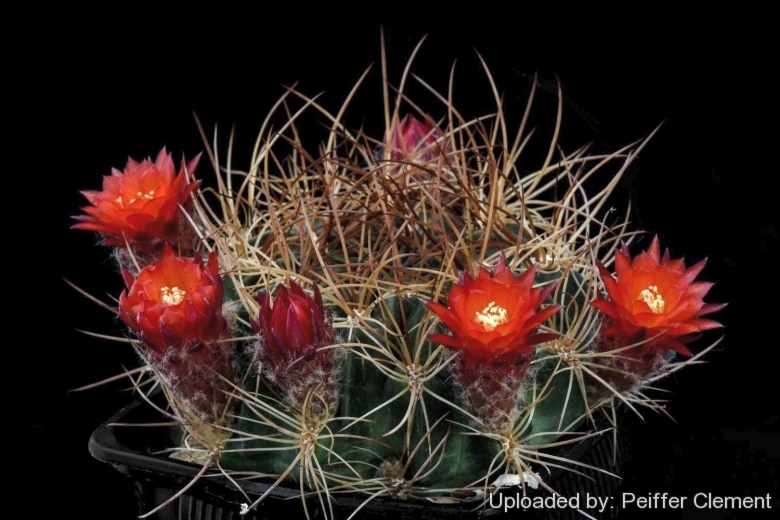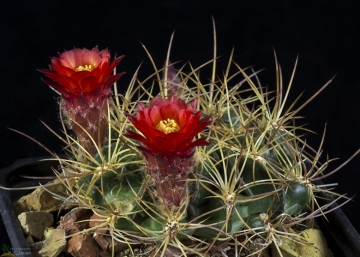Accepted Scientific Name: Echinopsis chrysochete Werderm.
Repert. Spec. Nov. Regni Veg. 39: 271. 1936 ( "chrysochele" )

Lobivia chrysochete var. minutiflora Photo by: Peiffer Clement
Origin and Habitat: Salta (Viscachani, Tres Lagunas, Santa Victoria, Salta, Iruya, Cerro Campanario, Pueblo Viejo, Chunca Chanca, Cerro Mandinga, Abra Lizoite, ) Argentina
Altitude range: 3500-4500 metres above sea level.
Haabit and ecology: Lobivia chrysocheteSN|21125]]SN|21125]] var. minutiflora grows among rocks on steep hillsides and ridges.
Synonyms:
See all synonyms of Echinopsis chrysochete
back
Accepted name in llifle Database:Echinopsis chrysochete Werderm.Repert. Spec. Nov. Regni Veg. 39: 271. 1936 ( "chrysochele" )Synonymy: 10
back
Description: Lobivia chrysocheteSN|21125]]SN|21125]] var. minutiflora is one of the local or morphological form of the very variable Echinopsis chrysocheteSN|21124]]SN|21124]] that shows a large range of natural variability, especially the colour of the flower. L. chrysochete var. minutiflora distinguishes for its smallish flower that expands to only 2,5 cm long.
Bibliography: Major references and further lectures
1) Walter Rausch “Lobivia: The Day Flowering Echinopsidinae from a Geographical Distribution Point of View”, Volumi 1-3 R. Herzig, 1975
 Lobivia chrysochete var. minutiflora Photo by: Peiffer Clement
Lobivia chrysochete var. minutiflora Photo by: Peiffer ClementSend a photo of this plant.The gallery now contains thousands of pictures, however it is possible to do even more. We are, of course, seeking photos of species not yet shown in the gallery but not only that, we are also looking for better pictures than those already present.
Read More... Cultivation and Propagation: This is an easy to grow succulent, more cold tolerant than most and less fussy regarding soil conditions.
Growth rate: It is a relatively rapidly growing and easily flowering species that will make smzsl clumps given the best conditions.
Soils: It likes very porous standard cactus mix soil.
Repotting: Use pot with good drainage.
Watering: Water regularly in summer, but do not overwater (Rot prone), keep dry in winter.
Fertilization: Feed with a high potassium fertilizer in summer.
Hardiness: Reputedly somewhat resistant to frost if kept on the dry side prior to, and during, cold weather (hardy to -12 C ° C, or less for short periods).
Exposition: Outside bright sunlight or afternoon shade, inside it needs bright light, and some direct sun. Tends to bronze in strong light, which encourages flowering and heavy spine production.
Uses: It is an excellent plant for container growing. It always looks good and stays small. It look fine in a cold greenhouse and frame or outdoor in a rockery.
Pests & diseases: It may be attractive to a variety of insects, but plants in good condition should be nearly pest-free, particularly if they are grown in a mineral potting-mix, with good exposure and ventilation. Nonetheless, there are several pests to watch for:
- Red spiders: they may be effectively rubbed up by misting the vulnerable plants every day.
- Mealy bugs: occasionally they develop aerial into the new growth among the wool with disfiguring results, but the worst types develop underground on the roots and are invisible except by their effects.
- Scales: they are rarely a problem.
It is wise to treat your whole collection with a systemic insecticide twice a year in spring and autumn.
- Rot: it is only a minor problem with cacti if the plants are watered and “aired” correctly. If they are not, fungicides won't help all that much.
Propagation: Division, direct sow after last frost. Seeds germinate in 7-14 days at 21-27° C in spring, remove gradually the glass cover as soon the plants will be well rooted (ca 1-2 weeks) and keep ventilated, no full sun for young plants! To make a cutting twist off a branch and permit it to dry out a couple of weeks, lay it on the soil and insert the stem end partially into the soil. Try to keep the cutting somewhat upright so that the roots are able to grow downward.











